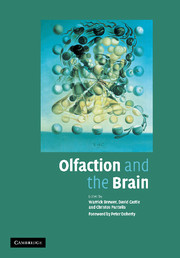Book contents
- Frontmatter
- Contents
- Foreword
- Preface
- List of Contributors
- Section I Neurology, Neurophysiology and Neuropsychology: Olfactory Clues to Brain Development and Disorder
- 1 Structure and Function of the Olfactory System
- 2 Olfaction and the Temporal Lobes
- 3 Role of the Insula in Smell and Disgust
- 4 Olfaction and Memory
- 5 Olfactory Neurogenesis: A Window on Brain Development
- 6 Olfactory Processing and Brain Maturation
- 7 Probes of Behaviour Regulation: Olfactory Models in Addiction
- Section II Social Functioning: Role of Evolution, Genetics and Gender
- Section III Assessment and Disorders of Olfaction
- Index
- Plate section
- References
2 - Olfaction and the Temporal Lobes
from Section I - Neurology, Neurophysiology and Neuropsychology: Olfactory Clues to Brain Development and Disorder
Published online by Cambridge University Press: 17 August 2009
- Frontmatter
- Contents
- Foreword
- Preface
- List of Contributors
- Section I Neurology, Neurophysiology and Neuropsychology: Olfactory Clues to Brain Development and Disorder
- 1 Structure and Function of the Olfactory System
- 2 Olfaction and the Temporal Lobes
- 3 Role of the Insula in Smell and Disgust
- 4 Olfaction and Memory
- 5 Olfactory Neurogenesis: A Window on Brain Development
- 6 Olfactory Processing and Brain Maturation
- 7 Probes of Behaviour Regulation: Olfactory Models in Addiction
- Section II Social Functioning: Role of Evolution, Genetics and Gender
- Section III Assessment and Disorders of Olfaction
- Index
- Plate section
- References
Summary
Introduction
There was a time in the history of anatomy and medicine when the temporal lobes were considered to be the olfactory brain. In an early paper describing a patient with a brain tumor and olfactory auras, Jackson and Beevor (1889a) refer to the ‘anterior tip of the temporo-sphenoidal lobe’ as the ‘pyriform or hippocampal lobule’ (p. 350). They also mention that Broca had described this part of the brain as being well developed in animals with a keen sense of smell, and as being rudimentary in animals with poorer smelling. Since then, our understanding of temporal-lobe function has evolved greatly. We know that the temporal lobes are heterogeneous structures consisting of several subregions, and that this complex set of structures participates in a wide variety of cognitive and emotional functions and behaviors. However, the old wisdom that the temporal lobes have a great importance in olfaction is still valid, and in this chapter, we review the main findings elucidating this relationship.
A brief overview: anatomy and uniqueness of the olfactory system
In most senses, the primary sensory area consists of one region, and adjacent areas usually constitute the secondary sensory regions. In olfaction, however, a whole series of structures constitutes the primary olfactory cortex (POC), and interestingly, some of these structures are not cortical. Carmichael et al. (1994) listed eight principal structures that constitute the POC in the macaque monkey, and a similar composition can be assumed in humans: the anterior olfactory nucleus, the ventral tenia tecta, the piriform cortex, the olfactory tubercle, the periamygdaloid cortex, the nucleus of the lateral olfactory tract of the amygdala, the anterior cortical nucleus of the amygdala and the rostral entorhinal cortex.
Keywords
- Type
- Chapter
- Information
- Olfaction and the Brain , pp. 28 - 49Publisher: Cambridge University PressPrint publication year: 2006
References
- 1
- Cited by



